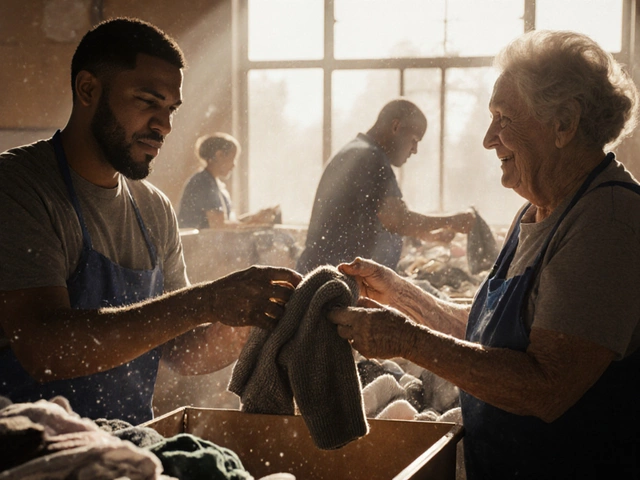Getting kids to show up to an after-school club isn’t just about having snacks and a cool name. If you’ve ever run a club that started with 15 excited kids and ended with three who came because their parents signed them up, you know the struggle. The secret isn’t more flyers or louder announcements. It’s about building something students feel they can’t live without.
Start with what they already care about
Don’t assume you know what teens want. Ask them. Walk into a classroom during lunch, hand out sticky notes, and ask: "What would make staying after school worth your time?" You’ll get answers like: "Someone who actually listens," "A place to chill without being told what to do," or "A chance to make something real."
One school in Wellington ran a survey like this and found that the top three requests weren’t sports or art-they were video editing, podcasting, and building mini robots. The staff had assumed they’d get more traditional requests. Instead, they built a club around student-driven tech projects. Within two months, waitlists formed.
Popular clubs aren’t planned by adults. They’re co-created with students. Let them name it. Let them pick the rules. Let them choose the projects. When ownership shifts, engagement spikes.
Make it feel like a space, not a class
Most kids don’t want another lecture. They want a place where they can be themselves. A popular club feels like a hangout with purpose.
Think about the layout. Fold-out tables, beanbags, string lights, a whiteboard for ideas, a small fridge with drinks students can grab after they’ve put in work. Play music they like-not background jazz, but actual playlists they made. Let them decorate the walls with their art, photos, or slogans.
At a high school in Lower Hutt, the "Digital Storytellers" club turned a storage closet into a podcast studio. They painted the walls black, added foam panels, and put up a sign that said: "No judgment zone. Just stories." Attendance jumped from 8 to 37 in one term. Why? Because it didn’t feel like school. It felt like theirs.
Give them real outcomes, not just participation
Students don’t stick around for "having fun." They stay for proof that what they do matters.
A club that ends with a presentation to the principal? That’s good. A club that ends with their podcast being added to the school’s website? Better. A club that gets their short film shown at a local cinema? That’s unforgettable.
One group of students in Porirua started a club called "Waste Not," where they collected plastic bottles from around the school and turned them into planters. They didn’t just make planters-they partnered with a local nursery, sold them at a market, and donated the profits to a food bank. The local paper covered it. The principal mentioned them at assembly. That club went from 12 members to 48 in three weeks.
Real outcomes mean real pride. And pride means return visits.

Find the quiet ones-and give them a spotlight
Popular clubs don’t just attract the loud kids. They pull in the ones who sit in the back, scroll on their phones, and never raise their hand.
Those students aren’t disinterested. They’re waiting for a way in that doesn’t require performing. A club that values behind-the-scenes roles-editing videos, managing social media, organizing supplies, designing posters-gives them a doorway.
At a school in Tauranga, the "Green Tech Club" had a student who never spoke up. But he was amazing at coding. The leader asked him to build a simple app that tracked how much energy the school saved each week. He did. The app showed real-time graphs on a screen in the main hall. Suddenly, he wasn’t the quiet kid. He was the guy who made the tracker. Other students started asking him for help. His confidence grew. More students joined.
Popularity isn’t about being the center of attention. It’s about making everyone feel they belong in their own way.
Keep it simple. Keep it consistent.
Don’t try to do too much. One club, one clear focus, one reliable time each week. That’s all you need.
Too many clubs fail because they’re chaotic. Meetings start late. Activities change every week. No one knows what’s happening next. Students get confused. They stop coming.
Successful clubs have rhythm. Every Tuesday, 3:30-5:00. Same room. Same snacks. Same opening ritual-maybe a quick check-in, maybe a 60-second video from last week’s project. Consistency builds trust. Trust builds belonging.
Even if you only have five students, show up. Always. If you’re late once, they notice. If you cancel once, they assume it’s not important. Show up like it’s the most important thing in your day-even if it’s not. That’s how you earn their respect.

Let them lead
The moment you stop being the boss and start being the guide, the club transforms.
Instead of saying, "We’re going to build a robot," say, "What do you want to build? How can I help you make it happen?" Let students pick the tools, set the deadlines, and assign roles.
At a primary school in Nelson, the "Mini Makers" club was led by a Year 6 girl who decided they’d build a solar-powered phone charger. She researched parts online, wrote a budget, and convinced the school to buy the materials. The teacher just showed up with a soldering iron and said, "Let me know when you need help." The project took six weeks. They didn’t finish perfectly-but they finished. And they were proud.
When students lead, they invest. When adults lead, they wait for permission.
Track what works-and share it
Keep a simple log. Not grades. Not attendance sheets. Just stories.
What did a student say this week? What surprised you? What did they build? Who helped whom?
At the end of each term, put together a one-page newsletter. Photos. Quotes. A short video. Send it to parents, the school newsletter, and local community boards. When families see what their kids are doing, they become advocates. And when the community sees the club as valuable, support follows-donations, guest speakers, even funding.
One club in Dunedin shared a video of their student-led composting project. The local council saw it and offered them free compost bins. That’s how small wins turn into big opportunities.
It’s not about being perfect. It’s about being real.
You don’t need a big budget. You don’t need fancy equipment. You don’t need to be an expert.
You just need to care enough to show up, listen enough to adapt, and brave enough to let go of control.
The most popular clubs aren’t the ones with the most resources. They’re the ones where students feel seen, heard, and capable. That’s the magic. And it’s something no flyer, no brochure, no school announcement can buy.
Start small. Listen harder. Let them lead. And watch what happens when you stop trying to make a club-and start helping students build something they love.
What’s the most common mistake when starting an after-school club?
The biggest mistake is assuming you know what students want without asking them. Many clubs fail because they’re built on adult assumptions-like thinking all teens want sports or drama. The truth? Students crave autonomy, real outcomes, and a space where they’re not just another participant. The clubs that thrive are the ones co-designed with students from day one.
Do I need special skills or training to run a club?
No. You don’t need to be an expert in robotics, coding, or art. You need to be curious, reliable, and willing to learn alongside the students. Many successful club leaders are teachers, parents, or community members who simply say, "I don’t know how to do this, but I’ll help you find out." That attitude builds trust faster than any certification ever could.
How do I get students to join if they’re shy or hesitant?
Start by inviting them one-on-one. Say something like, "I noticed you’re really good at [drawing, fixing things, writing stories]. I’m starting a club where people do that-would you want to try it out? No pressure, just come and see." Shy students respond to personal invitations, not group announcements. Also, give them a role that doesn’t require speaking up-like managing the music, organizing materials, or documenting the club. They’ll find their voice when they feel safe.
What if I only have a few students at first?
That’s fine. Start small. Focus on making those first few students feel like the club is theirs. Celebrate their wins. Share their work. When others see how much fun and meaning they’re having, they’ll want in. A club with 5 passionate members is more powerful than one with 30 who are just there because they have to be.
How do I keep the club going year after year?
Build a leadership pipeline. Every term, invite older students to help lead new members. Train them to run meetings, manage tools, and welcome newcomers. When students see that the club can survive without you, they feel ownership. Also, keep a simple archive: photos, project ideas, and student quotes. When new students join, show them what came before. It tells them: "This is real. People cared before you. Now it’s your turn."






